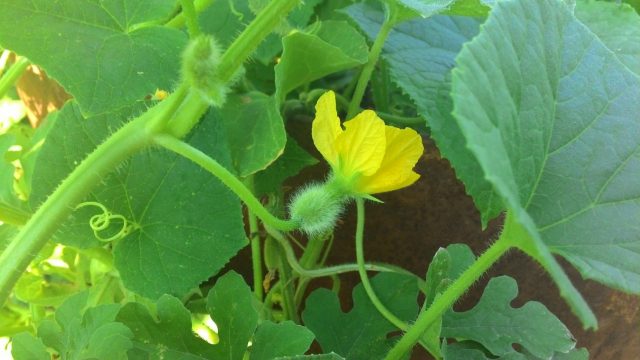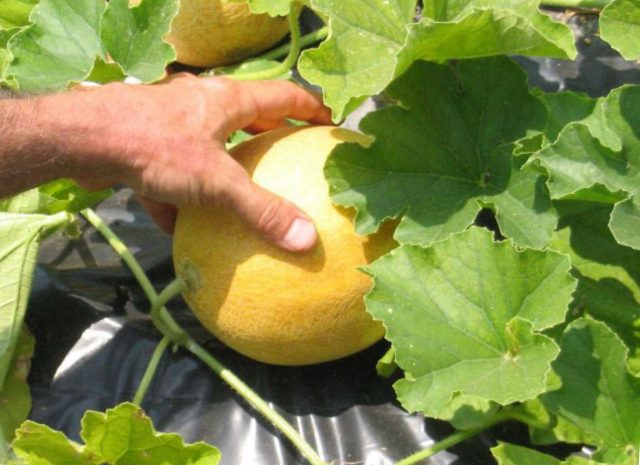Content
Melon Goldie f1 is a hybrid of French breeders. The copyright holder of the variety is Tezier (France). After experimental cultivation on the territory of the Russian Federation, the culture is entered into the State Register with the recommendation of cultivation in the North Caucasus region.
Description of Goldie melon f1
Melon Goldie is an annual crop of the pumpkin family, belongs to the early varieties, reaches biological ripeness in 2.5 months from the moment of germination. Suitable for open field cultivation in the southern regions, in a protected area in a temperate climate. It is planted in small beds and farm areas.
External characteristics of Goldie melon f1:
- herbaceous plant with a long, creeping, green stem, giving multiple shoots;
- leaves are large, dark green, slightly dissected, surface with fine pile, pronounced light streaks;
- flowers are light yellow, large, giving ovaries in 100%;
- the shape of the fruit is oval, weighing up to 3.5 kg;
- the peel is bright yellow, thin, the surface is mesh;
- the pulp is beige, juicy, dense in consistency;
- seeds are small, light, abundant.
Fruits with an excellent gastronomic value, sweet with a pronounced aroma. Melon Goldie retains its presentation and taste up to 30 days after harvest, tolerates transportation well, and is suitable for commercial cultivation. The fruits are universal in use. They are consumed fresh, melon honey, jam, candied fruits are made.
Pros and cons of the variety
The hybrid Melon Goldie f1 belongs to high-yielding varieties, the variety is self-pollinated, with a sufficient amount of ultraviolet radiation, all ovaries reach biological ripeness. The advantages of melon include:
- Early ripening.
- Good gastronomic score.
- Resistant to most fungal and bacterial infections.
- Does not require special agricultural technology.
- Contains many active substances that are beneficial to the body.
- The peel is thin, well separated from the pulp.
- The seed nest is small, closed.
- Long shelf life.
The disadvantage of Goldie melon includes: with a lack of sunlight, the vegetation slows down, the taste is lost, the variety does not provide full-fledged planting material.
Growing Melon Goldie
The melon variety is recommended for growing in warm climates. In the South, melons and gourds are cultivated in the open field. Can be grown in greenhouse conditions in Central Russia. The plant is thermophilic, can do without watering for a long time, does not tolerate waterlogging of the soil. Melon is grown from seeds in a seedling way.
Seedling preparation
They purchase planting material in specialized stores. Before placement in a permanent place, seedlings are grown. The works are carried out at the end of April. Time is calculated taking into account the peculiarities of the regional climate. Young shoots are placed in the ground one month after the emergence of shoots. Algorithm of actions:
- A fertile mixture is prepared, consisting of turf soil, river sand, peat and organic matter in equal parts.
- The soil is calcined, then placed in small planting containers (plastic or peat containers)
- Seeds are germinated a week before planting. They are laid out on ½ part of a damp cloth, covered with the other half on top, making sure that the napkin remains wet.
- Seeds with sprouts are placed in containers.
- Moisten the soil, cover it with foil or glass on top.
- Tucked into a lighted room.
After the emergence of young growth, the containers are placed in a place with a constant temperature and good access to ultraviolet radiation.
Selection and preparation of the landing site
Melon Goldie gives a good harvest, provided the soil composition is suitable. The soil must be neutral. If the composition is sour, dolomite flour is added in the fall, the bed is loosened. In the spring, the place reserved for the melon is loosened again, the roots of the weed are removed, and organic matter is introduced. Optimal soils for culture are black earth, sandy, sandy loam.
The site for planting is chosen flat, on the south side, well-lit, sunny. Melon should not be planted in the shade of trees or the walls of a building, in lowlands, in wetlands. On wet soils, the crop is at risk of root decay.
Landing rules
Seedlings are planted approximately at the end of May, when the soil warmed up at least +180 C. Goldie melon variety is early maturing, provided that the daytime air temperature is within +230 C, yields a crop in mid-July. Planting material is placed according to the following scheme:
- Depressions are made on the bed by 15 cm, the distance between the holes is 0.5 m, the width is chosen taking into account that the root system of the melon is completely located in the hole. Can be planted staggered or in one line. Row spacing 70 cm.
- Seedlings are poured, leaving 2 upper leaves on the surface.
- From above mulch with sand, watered.
To prevent the leaves from getting sunburn, a paper cap is installed over each seedling. After 4 days, the protection is removed.
Watering and feeding
Watering plants is carried out taking into account seasonal precipitation, if it rains once every 2 weeks, additional soil moisture is not required. In dry summers, two waterings per month will be sufficient. The first organic feeding of Goldie's melon is carried out 7 days after planting the seedlings. Two weeks later, a solution of ammonium nitrate is introduced under the root. The next fertilization is in 14 days. Dilute humus, add wood ash. Superphosphate and potash fertilizers are applied in equal proportions 3 weeks before harvesting.
Formation
Goldie melon bushes form after the first lateral shoots appear. The variety produces many shoots and intense flowering. It is necessary to remove excess layers so that the fruits receive a sufficient amount of nutrients. No more than 5 shoots are left on one bush, 1 large, lower fruit on each, the rest are cut off. 4 leaves are counted from the fruit and the top is broken. After the formation of the beds, all melons remain open, the excess growth is removed.
Harvesting
Goldie's melon ripens unevenly, the first harvest is carried out when the fruits reach biological ripeness, approximately at the end of July. The rest of the fruits remain to ripen until autumn. If the temperature drops below +230 C, the melon will not ripen. Therefore, when forming, the weather conditions of the region are taken into account. Ripe Goldie melon is bright yellow with a pronounced beige mesh and a pleasant aroma. If the fruits are removed in a state of technical ripeness, they will not be sweet, the shelf life is halved.
Diseases and pests
The Goldie melon hybrid is based on wild-growing crop species, therefore the variety is genetically immune to a number of diseases: powdery mildew, fusarium wilting, ascochitosis. The manifestation of a viral cucumber mosaic is possible. Treatment of the culture is carried out by removing the affected areas, treating the bushes with a manganese solution.
The only melon pest is the melon fly, which lays eggs under the skin of the fruit. The pest is able to completely destroy the crop. To prevent the multiplication of the parasite, the plant is treated with insecticidal preparations.
Conclusion
Melon Goldie f1 is a fruitful, early maturing hybrid created by French breeders. The culture is characterized by high taste.Produces fruits for universal use. Dessert melon variety is suitable for cultivation in the garden and large areas. The fruits are stored for a long time, safely transported.











